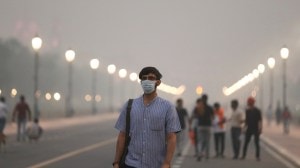What is PTSD in teens and its probable triggers
PTSD can affect a person’s ability to work, perform daily activities and relate to family and friends
 PTSD can be caused by a wide range of traumatic experiences, ranging from
accidents and natural disasters to the loss of a parent (representative) (Source: Freepik)
PTSD can be caused by a wide range of traumatic experiences, ranging from
accidents and natural disasters to the loss of a parent (representative) (Source: Freepik) Post-traumatic stress disorder (PTSD) is a disorder that develops in some people who have experienced a shocking, scary or dangerous event. A new study shows that close to one in every three teens has experienced PTSD symptoms as a result of the pandemic and its associated trauma. PTSD was once seen as something that only combat veterans and war refugees would struggle with, but new research shows that people of all ages can experience PTSD, even young children. Kids may develop PTSD in response to any one-time or repeated traumas that threaten their sense of
safety and security.
What Is PTSD in Teens?
PTSD can be caused by a wide range of traumatic experiences, ranging from accidents and natural disasters to the loss of a parent or other family member. A single traumatic event, such as a car accident or a violent incident, is known as “acute trauma.” Traumatic stress can last days, weeks or months following the event. A traumatic event is typically an event that results in or threatens death or injury. Moreover, experts define tragedy as an event or circumstance that creates intense distress or sadness.
Ongoing traumatic events, such as exposure to childhood abuse, domestic violence or gang violence, are called “chronic trauma.” Both acute and chronic trauma can lead to PTSD in teens. Moreover, children and teens can experience vicarious trauma , also known as secondary trauma, caused by indirect exposure to traumatic events via media, close friends or family members.
12 Common PTSD Symptoms in Teens
For stress to be considered PTSD, symptoms must last more than a month and be severe enough to interfere with daily functioning.
Symptoms include:
1. Flashbacks
2. Nightmares
3. Panic attacks
4. Confusion and inability to make decisions
5. Difficulty sleeping
6. Finding it hard to enjoy activities that were once pleasurable
7. Irritable or aggressive behaviour
8. Emotional numbness
9. Constantly feeling on edge
10. Avoiding people, places or situations that trigger memories of the traumatic event
11. Difficulty focusing
12. Suicidal thoughts
New statistics
The new study , published in the International Journal of Clinical Practice, measured mental health symptoms in 447 adolescents, using industry-accepted scales for anxiety, depression, and PTSD. Results showed that 28.5 per cent of the teens experienced moderate to high levels of PTSD. In addition, 28 per cent had anxiety symptoms and 37.6 per cent had depressive symptoms.
Impact of PTSD on relationships and day-to-day life
PTSD can affect a person’s ability to work, perform day-to-day activities or relate to their family and friends. A person with PTSD can often seem uninterested or distant as they try not to think or feel in order to block out painful memories. They may stop them from participating in family life or ignore offers of help. This can lead to
loved ones feeling shut out.
It is important to remember that these behaviours are part of the problem. People with PTSD need the support of family and friends but may not understand what is happening to them or think that they need help.
When PTSD goes on for some time, it is not unusual for people to experience other mental health problems at the same time. In fact, up to 80 per cent of people who have long-standing PTSD develop additional problems – most commonly depression and anxiety. These may have developed directly in response to the traumatic event
or as a result of the effects of having PTSD.
Why do some traumatised children develop PTSD and others don’t?
A child’s risk of developing PTSD depends on several factors:
The perceived seriousness of the trauma
Children who develop PTSD after being bitten by a dog may recover more quickly than those who have been kidnapped or sexually abused. That said, each child’s experience is unique, and their reactions will vary.
The frequency of the trauma
Children who have been traumatised over and over again may react very differently from those who experienced a single terrifying event.
The child’s proximity to the trauma
Did bad things happen at home? Next door? At school? Or much farther away?
Relationship with the victim
Kids who are direct victims of trauma may face much higher risks of developing PTSD than those who only witness traumatic events.
When to see a doctor
If you have disturbing thoughts and feelings about a traumatic event for more than a month, if they are severe or if you feel you’re having trouble getting your life back under control, talk to your doctor or a mental health professional. Getting treatment as soon as possible can help prevent PTSD symptoms from getting worse.
PTSD Help
Treatment for PTSD in teens can make all the difference. But sometimes stigma or fear can prevent a teen from asking for help. Therefore, parents and other adults need to monitor teens carefully after a traumatic event, as well as during a period of collective trauma. Teens suffering from PTSD need comprehensive and compassionate support in order to heal and move forward.
Alisha Lalljee is a psychologist, special educator and psychotherapist practising in Bandra



- 01
- 02
- 03
- 04
- 05



























